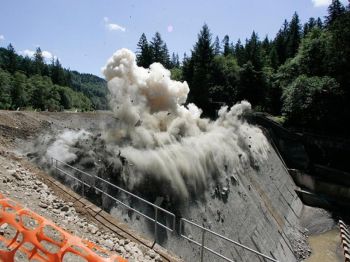Decommissioning

|
| A dam in the process of decommissioning.
(Image Source: Wikipedia) |
Beginning in the early 1600’s and into the 1900’s, thousands of dams were built to provide energy for grain and lumber mills, foundries. Some of these structures also produced electricity and facilitated transportation. Most of these dams were low-head dams. Many of these dams have outlived their design life and are no longer operating or providing the benefits they once were and are at risk of failing. Low head dams bar fish and other aquatic organisms from moving upstream, affecting upstream habitats and water quality, and are also drowning hazards for boaters and swimmers.
Dam owners and project stakeholders should weigh the maintenance costs associated with safely operating a dam against its useful benefits. Negative effects of aging dams can include the risk of a dam failure, an accumulation of river sediment and loss of useful reservoir storage, the continued prevention of fish passage, the continued alteration of downstream water temperatures, or a diminished ability to reduce both upstream and downstream flooding. “When the benefits provided by a dam have diminished over time, dam removal may be a less expensive alternative to continued maintenance and repair, or upgrades needed to address new dam safety or environmental concerns”.[1]
“The level of effort needed to design a dam removal should be based on the size of the dam and the level of risk to the public, environment, and downstream property and infrastructure. The removal of a small weir may not require a detailed design. However, the removal of a large dam would require a detailed design to help ensure the safe and successful project implementation. Different strategies are required for removing dams based on their purpose, structural design, reservoir size, and the materials trapped within the reservoir.”[1]
“Planning for dam removal generally includes these steps: define the purpose and need for the action; identify and engage stakeholders; assess the present downstream safety or environmental hazard risks; formulate alternatives, including removing the dam or repairing, improving, or maintaining the dam; assess environmental impacts under a range of reasonable alternatives; assess economic and financial costs and benefits under a range of reasonable alternatives”.[1]
“During and after dam removal, use flexible decision making that can be adjusted as outcomes from previous management actions and other events become better understood. Agree on the basic framework for monitoring, adaptive management, and decision-making for the overall project and incorporate that framework into the sedimentation management plan”.[1]
“The dynamic hydraulics and sediment processes involved in dam removal should be monitored and evaluated throughout dam removal and reservoir drawdown and for the duration of significant impacts. A systematic approach to performance monitoring and data collection can help quantify and evaluate impacts to determine how well the project meets objectives, how the reservoir and river are responding to the dam removal, and when adaptive measures may be needed. As noted in USSD 2015, ‘Monitoring can also help inform adaptive management plans by reducing uncertainty associated with dam decommissioning projects, communicate project results to stakeholders and the public, and advance our understanding of the results of restoration actions for future projects’”.[1]
Best Practices Resources
![]() USA Dam Removal Experience and Planning (ENV-2021-97), USBR
USA Dam Removal Experience and Planning (ENV-2021-97), USBR
![]() Dam Removal Analysis Guidelines for Sediment, USBR
Dam Removal Analysis Guidelines for Sediment, USBR
Trainings
![]() On-Demand Webinar: Introduction to Dam Decommissioning
On-Demand Webinar: Introduction to Dam Decommissioning
Citations:
Revision ID: 7836
Revision Date: 03/28/2024
